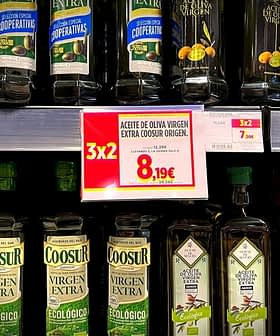Despite the vast majority of the world struggling to contain the Covid-19 pandemic, global olive oil consumption did not falter, according to the latest report from the International Olive Council (IOC).
The IOC estimates that consumption will reach 3.211 million tons in the 2020/21 crop year, which ends in September, just 0.2 percent less than the previous year.
Spain is a country that is currently not in its best range of olive oil production, due to several reasons.
However, global olive oil production is estimated to reach 3.034 million tons, a decrease of 6.9 percent compared to last year, but just 1.7 percent below the rolling five-year average.
Meanwhile, imports are also down 9.3 percent, hitting 1.074 million tons and exports are down 8.8 percent, at 1.132 million tons.
See Also:2021 Harvest UpdatesSpain once again confirmed its role as the leading olive oil producer, with production for the current crop year estimated to reach 1.4 million tons, a 24 percent increase compared to the previous year and 1.9 percent above the rolling five-year average.
This year’s yield is the second-highest for Spain in the past half-decade, but well below the 1.785 million tons recorded in the 2018/19 crop year. According to Juan Vilar, an international olive oil consultant, Spanish production is still not reaching its full potential.
“Spain has enough olive trees to achieve, as of right now, two million tons of olive oil production,” Vilar told Olive Oil Times. “Spain is a country that is currently not in its best range of olive oil production, due to several reasons such as low percentage of oil in the fruit, bad climatic conditions, poor management of traditional olive trees at a time of low prices and so on.”
However, Spain’s substantial production increase was partially balanced out by a sharp production fall in Italy, the second-largest producing country. This crop year, Italy produced 270,000 tons, roughly as much as Greece. This year’s yield was 27 percent lower than the previous year’s and five percent below the rolling five-year average.
“That is not surprising,” Anna Cane, president of the olive oil Group within the Italian Association of the Oil Industry (Assitol), told Olive Oil Times.
“Italian olive farming cannot cover olive oil demand,” she added. “Companies require one million tons of olive oil from the agricultural sector per year for both exports and the internal market, quotas far above our national production. We need imports but we also need to increase national yields.”
In a press note, the president of the olive oil federation within the farming association Confagricoltura, Walter Placida, said that “the strong reduction of our yields has become endemic. We need to counter it soon with an active and practical approach.”
According to Cane, the Italian olive oil sector must push to innovate, while focusing on the best farming practices and deploying new technologies and digitalization throughout the sector.
“All of this is often seen by some in the industry as an attack on tradition,” she said. “On the contrary, it is the best way to safeguard our history and our products which are surrounded by competitors whose strengths lie in innovation and their ability to act as a homogenous production chain.”
Meanwhile, Greece experienced only a minor production drop of 1.8 percent compared with the previous year, but 5.8 percent below the rolling five-year average. Portugal also experienced a substantial decrease, with production dipping to 100,000 tons, 28.8 percent less than 2019/20 and 8.3 percent below the rolling five-year average.
On the other side of the Mediterranean Sea, production in Morocco rose to 160,000 tons, 10 percent higher than the previous year and six percent higher than the rolling five-year average.
However, neighboring Tunisia saw its production fall to just 140,000 tons after a record harvest in 2019/20, one-third below the rolling five-year average. Production in Algeria also fell substantially dropping to 90,000 tons, slightly below the rolling five-year average.
On the eastern shores of the Mediterranean, production in Turkey fell slightly to 210,000 tons, just below the rolling five-year average.
“The downturn in production in Spain, Italy, Greece, Portugal and Tunisia means that countries such as the United States, Chile and Australia, which hold five percent of olive oil production and are not IOC members, will increase their specific role,” Vilar said. “Out of the 67 countries that produce olive oil, their total olive groves area comprise six percent.”
IOC member countries account for 92 percent of the olive crop area and 93 percent of the total world olive oil production in the last season.
The IOC estimates that the largest olive oil markets – Bari in Italy, Chania in Greece and Jaén in Spain – comprise more than 60 percent of the global olive oil production.
“Prices in these three countries, particularly in Spain, have an impact on other producing countries, and mainly on the oils they intend to export,” the IOC said.
In the last 10 years, the average extra virgin olive oil price in Jaén was €274.90 per 100 kilograms, while its price is now at €326.50 per 100 kilograms.
In Bari, the average for that period was €419.10, and it is now at €460. The same trend is seen in Chania, where the average in the last decade was €268.90 against the current €315 per 100 kilograms.
However, prices and trends of the international olive oil market are more and more affected by the non-IOC countries’ olive oil imports.
Vilar added that even though olive oil consumption is increasingly popular throughout the world because of the strong appeal of olive oil’s healthy qualities, there is room for further growth.
“Of the 199 countries that consume olive oil, the IOC countries account for 86 percent of the demand while the non-IOC nations acquire a greater role, that is, they account for 13 percent of the total consumption, mainly due to the demand experienced by the United States,” he said. “The rest of the countries, 156, achieved just one percent of the total consumption.”
According to the recent estimates by the United States Department of Agriculture, global olive oil consumption is expected to grow steadily, given the growing popularity of the product and the growing prices of alternative vegetable oils.
The European Commission also estimates that global olive oil consumption will increase by at least five percent by the end of the decade.








